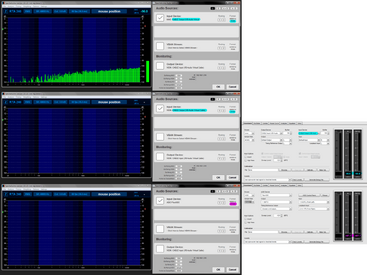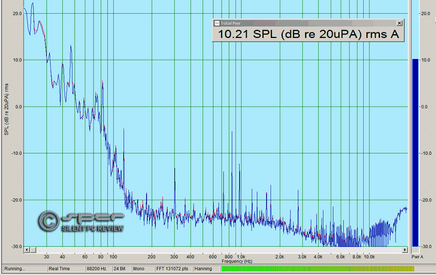preface: I've used the umik-1 & rew in the past, it's been helpful for combating my listening rooms response.. so thanks for all your efforts!
Hello, I hope you don't mind having several related-ish questions in a thread
I've seen videos on youtube where musicians may take an umik-1 and hammer out the response of another microphone, calibrated mic -> calibrated speaker -> mic to be calibrated
Would it be possible to then turn any EIN <6dB(A) microphone into one that could take accurate SPL measurements too? I suspect gain knobs complicate things.
The source input selection in rew was limited to MME:16/48 -96.7dBFS levels which can't go below 14dB(A) in the spl meter&logger, after switching to ASIO - WASPAI shared via FlexASIO I could enable 24/48 -487.7dBFS levels which goes down to -125.8dB(A). My system is W7x64, with virtual cables as a source for the moment with an unrealistic SNR.
I suspect if do get an interface to power a quality mic* it would have ASIO drivers to bypass the limitation of <15dB(A) measurements. I'd like to build a small chamber to measure computer components in for now, a hemi-anechoic studio would be living the dream.
I've fed my virtual cables with youtube recordings to see what sort of levels they had in rew, I read dBFS -> SPL is something that 'doesn't happen'
If I had a way to calibrate, would that be possible then? I assume rew is doing it somehow. The video publishers had measured a 6.4dB(A) component, but all their published recordings have gain applied for easy listening with headphones. Sadly they don't go over their SPL testing equipment, and have ceased publishing videos for some time.
The metrics for video game performance have shifted from avg FPS to avg FPS & 1% lows, or even 0.1% lows to highlight any poor characteristics that may be averaged over
My untested idea would be to export many Plot Spectrum(s) (Audacity) from a recording, and give an avg dB(A) with highlights on peaks that sit high above the rest of the spectrum. An objective approach compared to relying on publishing audio samples with gain applied.
In video games 60FPS is an image every 1/60 or 16.67ms, with a new top-end monitor hitting 360FPS or image every 1/360, 2.78ms, camera's with >960FPS exist
What sort of rate/realm does recorded 'audible to humans' audio operate at? in Audacity that Plot Spectrum feature, the Algorithm, Size, and Function (window) appear to show me, in video game terms, partial images if my selection is too small (less than a second in some instances) for example.
*If I had theoretically purchased say a cardioid mic with 130dB of dynamic range and selfnoise of 4dB(A), and an interface with EIN -129dBu(A) with a dynamic range of 115dB(A), and gain of 50dBFS
What kind of measuring resolution in dB(A) might be possible, if the calibration is possible and the small chamber (relative to an entire room) was constructed well? I suspect that's how youtube publishers were able to get their measurements down that far.
Orfield Laboratories may be within my state (2013, -13dB(A) chamber) but I suspect the expense of multiple visits would be prohibitive.
If I'm way off base feel free to let me know, I see the >$2,500 lab mic/preamps on the internet too but thought to ask about the above first which may be more hobbyist friendly. Recording a snail eating lettuce is neat and all (google GRAS 40HF), but I think I'd like to do much more than read a displays readout. I don't suppose their second hand market is a thriving either.
Hello, I hope you don't mind having several related-ish questions in a thread
I've seen videos on youtube where musicians may take an umik-1 and hammer out the response of another microphone, calibrated mic -> calibrated speaker -> mic to be calibrated
Would it be possible to then turn any EIN <6dB(A) microphone into one that could take accurate SPL measurements too? I suspect gain knobs complicate things.
The source input selection in rew was limited to MME:16/48 -96.7dBFS levels which can't go below 14dB(A) in the spl meter&logger, after switching to ASIO - WASPAI shared via FlexASIO I could enable 24/48 -487.7dBFS levels which goes down to -125.8dB(A). My system is W7x64, with virtual cables as a source for the moment with an unrealistic SNR.
I suspect if do get an interface to power a quality mic* it would have ASIO drivers to bypass the limitation of <15dB(A) measurements. I'd like to build a small chamber to measure computer components in for now, a hemi-anechoic studio would be living the dream.
I've fed my virtual cables with youtube recordings to see what sort of levels they had in rew, I read dBFS -> SPL is something that 'doesn't happen'
If I had a way to calibrate, would that be possible then? I assume rew is doing it somehow. The video publishers had measured a 6.4dB(A) component, but all their published recordings have gain applied for easy listening with headphones. Sadly they don't go over their SPL testing equipment, and have ceased publishing videos for some time.
The metrics for video game performance have shifted from avg FPS to avg FPS & 1% lows, or even 0.1% lows to highlight any poor characteristics that may be averaged over
My untested idea would be to export many Plot Spectrum(s) (Audacity) from a recording, and give an avg dB(A) with highlights on peaks that sit high above the rest of the spectrum. An objective approach compared to relying on publishing audio samples with gain applied.
In video games 60FPS is an image every 1/60 or 16.67ms, with a new top-end monitor hitting 360FPS or image every 1/360, 2.78ms, camera's with >960FPS exist
What sort of rate/realm does recorded 'audible to humans' audio operate at? in Audacity that Plot Spectrum feature, the Algorithm, Size, and Function (window) appear to show me, in video game terms, partial images if my selection is too small (less than a second in some instances) for example.
*If I had theoretically purchased say a cardioid mic with 130dB of dynamic range and selfnoise of 4dB(A), and an interface with EIN -129dBu(A) with a dynamic range of 115dB(A), and gain of 50dBFS
What kind of measuring resolution in dB(A) might be possible, if the calibration is possible and the small chamber (relative to an entire room) was constructed well? I suspect that's how youtube publishers were able to get their measurements down that far.
Orfield Laboratories may be within my state (2013, -13dB(A) chamber) but I suspect the expense of multiple visits would be prohibitive.
If I'm way off base feel free to let me know, I see the >$2,500 lab mic/preamps on the internet too but thought to ask about the above first which may be more hobbyist friendly. Recording a snail eating lettuce is neat and all (google GRAS 40HF), but I think I'd like to do much more than read a displays readout. I don't suppose their second hand market is a thriving either.
















